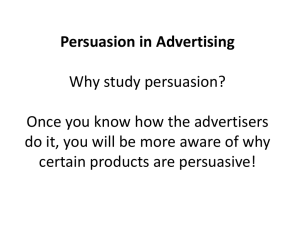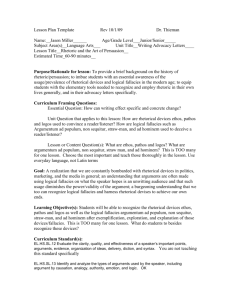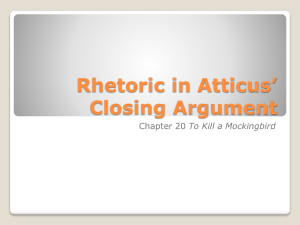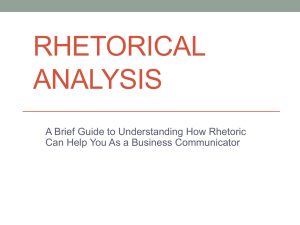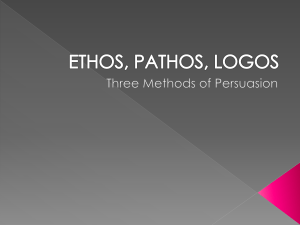Bellringer: Feb. 6 and 9
advertisement
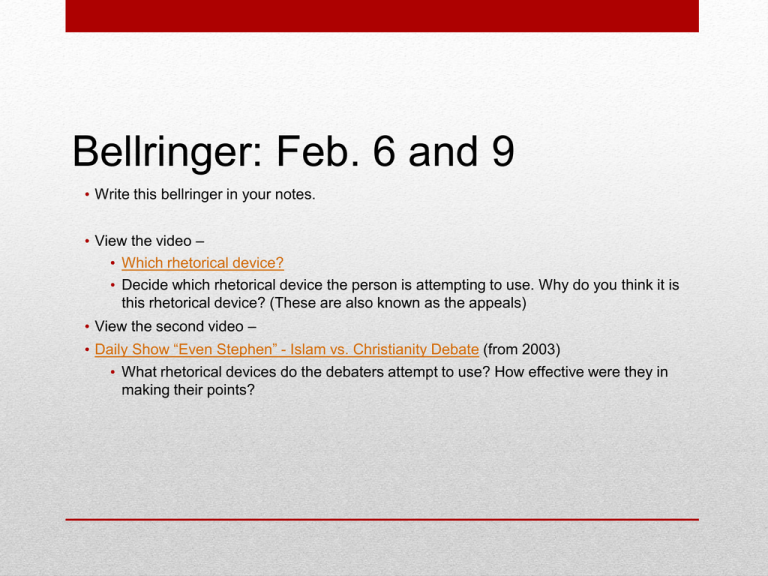
Bellringer: Feb. 6 and 9 • Write this bellringer in your notes. • View the video – • Which rhetorical device? • Decide which rhetorical device the person is attempting to use. Why do you think it is this rhetorical device? (These are also known as the appeals) • View the second video – • Daily Show “Even Stephen” - Islam vs. Christianity Debate (from 2003) • What rhetorical devices do the debaters attempt to use? How effective were they in making their points? • Sometimes internal: • Happens inside of the reader when understanding who is speaking • Sometimes external: • Happens in a piece when an author mentions her qualifications • Belongs a bit more with persuasion • However, in both argumentation and persuasion, the validity and relevance of evidence depends on the reputation of the source • Remember – to have ethos, you have to just have the best interests of your audience at heart with nothing to gain from it yourself. Ethos • Manipulating emotions • Very effective for large/wide audiences • Particularly effective in speeches. Get fired up y’all! • Should be eliminated in argumentation Pathos • Sheldon video • Proper logic is always a requirement • Think of it like the meat of a sandwich • Argumentation only has space for logic! • Spare your word choice! Stay neutral! • Persuasion still needs it, but you can throw in a healthy dose of the Pathos if needed depending on who your audience is. • Too much logic? What would it be like to have a dinner party with Sheldon? • Fallacies: sometimes things that sound logical, aren’t in reality. Common errors in logic are called fallacies. • Most emotional appeals are actually fallacies. • Logical Fallacy site • Purdue University’s Logical Fallacies Site • The most comprehensive list I’ve seen. Logos • We are going to be analyzing the organization of both pieces. • There are two sections of text that we will be adding in. • Concession: basically when you grant something as a right, accept something as true, or acknowledge defeat • Rebuttal or counterargument: bringing up an opposing appeal or claim for the purpose of invalidating it. Organization • Orval Eugene Faubus (January 7, 1910 – December 14, 1994) was the 36th Governor of Arkansas, serving from 1955 to 1967. • When the United States entered World War II, Faubus joined the United States Army and served as an intelligence officer with the Third Army of General George Patton. • He rose to the rank of major and was in combat several times. • He was elected governor as a liberal Democrat. Initially considered a 'moderate' on racial issues. • He adopted racial policies that were palatable to influential white voters in the Delta region as part of a strategy to affect key social reforms and economic growth in Arkansas. • Tried to forcibly keep African-American students out of the schools. The Speaker-Orval Faubus • The school district of Little Rock was ordered by the Supreme Court to enact their integration plan. • Watch this. The Situation-Integration of public schools in Little Rock, Arkansas • Faubus tries to convince the public that the state would not support the “forcible integration” of Little Rock Schools. • Audience: Essentially the entire nation, but mainly the people of Arkansas • Is it really the entire state? The speech-Television Address September 2nd, 1957 • What is the main idea of the sections you read today (of Faubus’s speech)? Ticket out • Read the speech with your partner using PALS. • Identify the organization of the speech using the graphic organizer • Identify the rhetorical devices for each section of the text • Look for logos • Look for logical fallacies • Look for pathos • Word choice • Specific examples chosen • Answer LEQ using graphic organizer: • How does Faubus employ ethos, logos, and pathos to build an argument? Instructions
